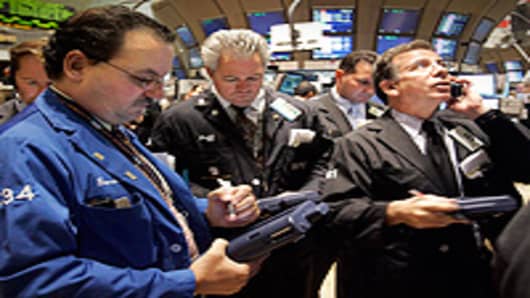Tuesday's explosive stock rally, fueled by the Federal Reserve's latest efforts to stem the credit crisis, is convincing more people on Wall Street that the market may finally be nearing a bottom.
Of course, such predictions have proven wrong before. Every time investors thought the market had hit bottom in recent months, it just ended up going lower. Wednesday's selloff was a reminder of that, suggesting Tuesday's big runup was just another bear market rally.
Still, some think things might really be different this time--mainly because of Bear Stearns and the Fed.
The fact that Bear nearly went bankrupt over the weekend and the market didn't collapse convinced many pros that a turning point may have been reached. The main reason was that the Fed, led by Ben Bernanke, helped engineer Bear's rescue and promised to help other Wall Street firms facing a liquidity crisis.
"My feeling is that Bear Stearns was ... the big one that everyone was waiting for, and now we have a 'Bernanke put' on the market," said Michael Cohn, of Atlantis Asset Management. "And I think you can start to deploy undeployed assets from here."
Cohn was hardly alone in his assessment of the market, though few were expecting stocks to just go straight up. Cohn predicted the market would again test its lows, but would fall short.
"You never know if one day it will really be different this time," Quincy Krosby, chief investment strategist at The Hartford, says. "It feels like a very, very strong bear market rally, but you've got some positives going in the market right now which will be very good for the market."
Sentiment that the market may have found a bottom became pervasive enough that some money managers were talking about the potential for missed opportunities as the market rallies.
"It would appear that you've priced in the likelihood of any future risk," said Jerry Castellini, of Castleark Management, who praised the Fed for its three-quarter-point rate cut as well as the opening of the discount window and last week's liquidity move. "The things they've done are so unprecedented and so broad-reaching I think they're going to create more upside risk than downside risk by a huge factor."
With the sharp turnaround in market psychology, the only question left was where to put money that has been on the sidelines waiting for an entry point.
Harry Clark, CEO at Clark Capital Management, likes metals and mining; bellwether industrials such as Caterpillar , Boeing and Deere ; and home builders, particularly exchange-traded funds in the sector rather than individual company stocks.
Cohn also likes metals, while also recommending basic materials, agriculture, oil and infrastructure.
"You've got to start buying the stuff that got hit the most," Clark said on CNBC. "They'll recover the most over the next 12 months."
Visa's IPO also took focus during the day, skyrocketing from its offering price of $44 to around $60 for much of the day, giving analysts more reason to expect good things from the market.
"I think this is one in a series of very positive developments this week that hopefully when we look back will mark a bottom," said David DiPietro, president of Signal Hill. "It has people looking at this as a great company at a great price, and hopefully investors will carry that mode of thinking into the broader marketplace."
Michael Farr, president of Farr, Miller & Washington, also was among those finding a bottom, and he also recommends turning to some of the market stalwarts for value. Farr recommends AIG, General Electric and Johnson & Johnson.
But John Buckingham, of Al Frank Asset Management, warns that the road can still be rocky and investors should "stay true to your discipline and maintain those portfolios and invest for the long haul."


